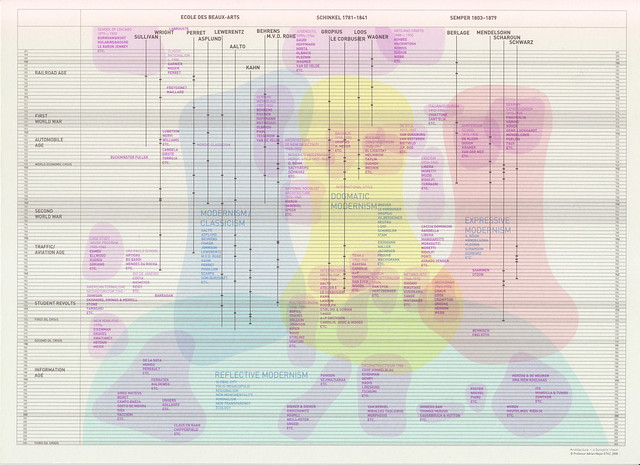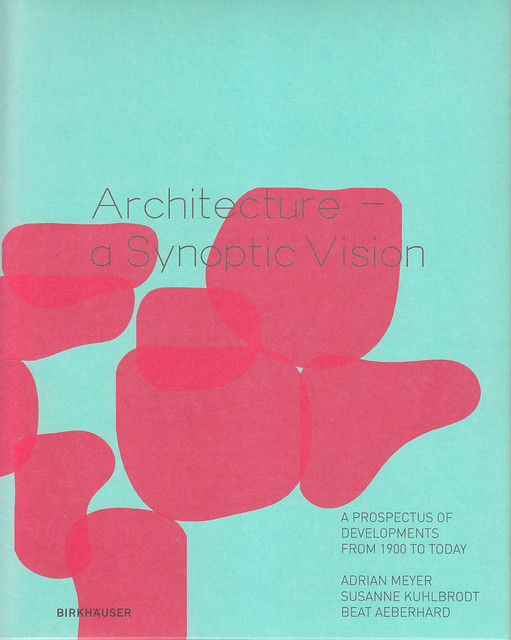Its the fascination with the past as the struggle to organise memories to make sense of the present that shapes the desire to redraw history. And in many ways this synopsis does redraw the past hundred years, in colour and blogs, with lines and words. The three authors Adrian Meyer, Susanne Kuhlbrodt and Beat Aeberhard put their vision of the past forward as an 'example of an evolutionary history'.

Image by Adrian Meyer, Susanne Kuhlbrodt and Beat Aeberhard / Card showing the style and movement developments in architecture during the 20th century. Taken from 'Architectur : a Synoptic Vision' by Adrian Meyer, Susanne Kuhlbrodt and Beat Aeberhard, published by Birkhauser.
They note in the introduction the changes in how architecture is thought and practiced and how distinct movements have been lost in the course of the years to drown in the global distribution and the enormous availability of information. They note: "These differing views have marke contemporary discourse on architecture as a highly controversial and at the same time ideological exercise".
The large poster chart is one part of the publication and summarises in a downwards direction visually the development and different groupings in architectura style and theory. Structurally dominant are the three concepts of Modernism/Classicism, Dogmatic Modernism and Expressive Modernism. Where as Schinkel stands above the Dogmatic Modernism and Semper above the Expressive Modernism, the Ecole des Beaux-Art stands at the beginning of Modernism/Classicism. The three blobs are augmented in detail with names of architects practicing in the tradition of one of the three areas. For important figures milestones, key projects are also listed. So for example Kahn is represented with the Yale Art Gallery, New Haven Connecticut, 1951-53, as part of the Modernism/Classicism. Le Corbusier stand for the Dogmatic Modernism with for example Unite d'Habitation, Marseille 1946-52. And Hans Scharoun forms part of the Expressive Modernism with for example the Philharmonie, Berlin, 1960-63.
So far for the main body of the hundred year chart. It becomes more complicated in recent years, where, as the authors note: "The positioning of contemporary attitude, in particular, is speculative and can only be preliminary in nature because of the historical distance for a more thoroughly examined allocation is still missing".
As a result the recent thirty years are part of the same blob. Visually the three distinct streams merge into one, around the first and the second oil crisis (1972 and 1979 respectively) as the Reflective Modernism. At the same time though, the sub categories become many and smaller unnamed groupings of practices and architects form. so is Foster, Nouvel and Piano a blob, or Diener&Diener, Krischanitz, Maerkli and Snozzi for example. But of course aso features Herzog de Meuron or Sauerbruch Hutton, Kollhoff and Chipperfield. Any name you can think of in a current architecture landscape is put down on the time axis with a group indication.

Image taken from MoMa / Brick Country House, project, Potsdam-Neubabelsberg, Plan
Ludwig Mies van der Rohe (American, born Germany. 1886-1969) 1964. Ink on illustration board, 30 x 40" (76.2 x 101.6 cm). Mies van der Rohe Archive, gift of the architect. © 2011 Artists Rights Society (ARS), New York / VG Bild-Kunst, Bonn
In the accompanying booklet the authors discuss briefly the main characteristics of space styled topics over the period. The idea is to illustrate "humankind's interaction with built space" using archetypal buildings. The topic are 'the Centre' with Kahn and Schinkel, 'the Horizontal' with SANAA and Mies, 'the Third Dimension' with Loos and Hertzberger, as the three keys.
The thing with time is the constant struggle for order and there have been previously and there will be many other attempts to make sense of it all, bring history in order and paint one consistant picture. This can only ever be done from the current moment of being in retrospect with the whole rucksack of knowledge and experience, values and desires. In this sense each attempt is a very momentary and personal eg subjective one. However, this is not in any way diminishing the value of any of these attempts, on the contrary, it highlights the importants it has for the moment as well as the identity it creates. In some ways the interpretation of the past has to be interpreted as the image of the present.
This is a great publication and the poster should be pined up at every office entrance, of course with the office positioning its elve in the context of such a temporal framework. The playful integration of history as a stimulant for visions, definitely a creativity field manual.

Image by Adrian Meyer, Susanne Kuhlbrodt and Beat Aeberhard / Cover of Architectur : a Synoptic Vision by Adrian Meyer, Susanne Kuhlbrodt and Beat Aeberhard, published by Birkhauser.
Via Birkhauser, additional review can be found at Archidose.
Meyer, A., Kuhlbrodt, S. & Aeberhard, B., 2008. Architecture -- A Synoptic Vision Pap/Chrt., Basel: Birkhauser.
Tidak ada komentar:
Posting Komentar